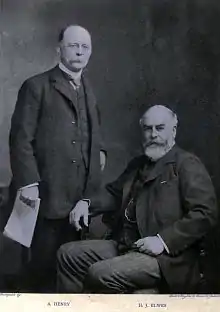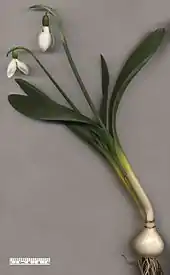Henry John Elwes
Henry John Elwes, FRS (16 May 1846 – 26 November 1922) was a British botanist, entomologist, author, lepidopterist, collector and traveller who became renowned for collecting specimens of lilies during trips to the Himalaya and Korea. He was one of the first group of 60 people to receive the Victoria Medal of the Royal Horticultural Society in 1897. Author of Monograph of the Genus Lilium (1880), and The Trees of Great Britain & Ireland (1906–1913) with Augustine Henry, as well as numerous articles, he left a collection of 30,000 butterfly specimens to the Natural History Museum, including 11,370 specimens of Palaearctic butterflies.[1]
Henry John Elwes | |
|---|---|
 Henry John as a young man | |
| Born | 16 May 1846 Cheltenham, Gloucestershire, England |
| Died | 26 November 1922 (aged 76) England |
| Nationality | British |
| Alma mater | Eton College |
| Known for | Galanthus elwesii Eremurus elwesii Genus Lilium |
| Awards | Victoria Medal |
| Scientific career | |
| Fields | Botany Entomology Lepidoptery Arboriculture |
| Institutions | Royal Horticultural Society |
Biography
Henry John Elwes was the eldest son of John Henry Elwes of Colesbourne Park near Cheltenham, Gloucestershire. He was described as "a giant of a man, and a very dominating character"[2] with "a booming voice which carried well across his Gloucestershire estate, but was very disconcerting elsewhere."[3] At 13, Elwes was sent to Eton College. After the age of 17 he spent at least part of every year abroad, and was sent to tutors in Paris, Brussels and Dresden before spending five years in the Scots Guards from 1865. He apparently did not take soldiering very seriously, being more interested in ornithology which in those days consisted of collecting specimens and eggs. He resigned his commission in 1869 and lived the life of a travelling naturalist and country gentleman. He visited various parts of the world studying aspects of natural history including ornithology, botany, entomology and big game.[4] He combined horticulture with entomology and big game hunting with estate management and raising prize-winning show livestock, and sitting on the district council. He would later ascribe his interest in plants to his wife, Margaret Lowndes, whom he married in 1871. His first garden was at Miserden, near Cirencester; he later moved to Preston House, Cirencester, before inheriting the Colesbourne estate on the death of his father in 1891.
Career
In 1870, after achieving a diploma in biology with a thesis in natural history, Elwes was made a member of a mission organised by the Geographical Section of the British Association which would take the party through to the Sikkim Himalaya, crossing the border into then-forbidden Tibet. The journey was inspired by reading Joseph Dalton Hooker's Himalayan Journals; it was the first of Elwes' many visits to Asia, and resulted in the major paper "On the geographical distribution of Asiatic birds" read to the Zoological Society in 1873. This was his last major ornithological contribution, as his interest moved on to insects and, increasingly, to plants. It was this visit to the Himalaya that sparked his interest in Lepidoptera; his Sikkim expedition alone yielded nearly 530 records of butterflies. Elwes' visit to Turkey in 1874 was somewhat fortuitous as it replaced a trip to Cyprus at short notice. It is evident that on this journey Elwes' interest was focused on plants, and he collected numerous species of bulbs. In early April, whilst in the mountains near Smyrna (modern Izmir), he came across "the fine large snowdrop which now bears my name" (Galanthus elwesii). Before leaving Turkey he arranged for bulbs to be collected later; the first of the many millions exported ever since.
In 1880 he visited India, accompanied by Frederick Du Cane Godman and the two visited Allan Octavian Hume before proceeding to Sikkim.[5] He also made collection trips to the United Provinces, the Punjab, the Central Provinces, Bengal, South Canara and Travancore. Along with T. Edwards, Elwes wrote a monograph on the Oriental Hesperiidae.[6] He also made a trip to the Altai region in 1898. His posthumously published Memoirs (1930) includes a chapter describing his visit to Nepal in 1914, at a time when Europeans were seldom admitted. He also mentions an unnamed companion, now known to be the English naturalist Aubyn Trevor-Battye, who took some of the photographs used to illustrate this chapter.[7] Elwes was famous for his breeding of Nerine and Eremurus. Horticulturalist and garden writer Edward Augustus Bowles noted that he was specially interested in Arisaema, Crinum, Crocus, Fritillaria and Iris, as well as Kniphofia, Paeonia and Yucca. Bowles' memoir in Elwes' posthumous biography offers most information about the Colesbourne garden, but even this is scanty.[8]
In 1902 Elwes presented his collection of 25,000 moths and butterflies to the Natural History Museum, London.[1][9] In 1920 James John Joicey acquired the "extensive collection of Lepidoptera, (nearly 11370 specimens) with the exception of the Indo-Australian Moths and types of the Palaearctic species, formed by H. J. Elwes".[10] (Much of Joicey's collection was also later donated to the Natural History Museum.)[11]
.jpg.webp)
Monograph of the Genus Lilium
Elwes' horticultural interests largely concentrated on bulbs, and he was said to have the finest collection in private hands. In 1880, he published the magnificent folio Monograph of the Genus Lilium, instigated by Elwes and written with assistance from J. G. Baker at Kew Gardens, but he wrote disappointingly little about his gardening experiences. To ensure that the text was as accurate as possible, and that the range of lilies was as complete as possible, he consulted the greatest botanical experts in the field for help in writing the text. This level of excellence was perpetuated in the illustrations, and Elwes was able to execute his plan to illustrate the monograph with hand-coloured plates by the best available botanical artist, with each member of the genus shown full size. Between March 1877 and May 1880 subscribers received seven parts (at a total cost of seven guineas), illustrated with 48 plates by Walter Hood Fitch (1817–1892). In his garden he was able to grow many of the members of the genus Lilium, becoming a recognised expert in the field. However, Elwes played down his level of knowledge. Some botanists found him a domineering personality. N.D. Riley noted that Elwes "was a giant of a man and a very dominating character." W.T. Stearn noted that his booming voice (which made one commentator quip - "is that a man or a foghorn?") which carried well across his Gloucestershire estate was disconcerting elsewhere.[12]

Shortly before his death in 1922, Elwes asked Arthur Grove, a friend and fellow lily expert, to undertake the task of producing a supplement. Dame Alice Godman, widow of Frederick DuCane Godman (whose first wife was Elwes' sister), agreed to underwrite the cost of the work (co-written by Grove and the botanist A.D. Cotton) and the first seven parts of the supplement were published between July 1933 and February 1940, with 30 hand-coloured lithographed plates, all but two by Lilian Snelling (1879–1972).[13] Two final supplements were published in 1960 and 1962 by William Bertram Turrill.
Trees of Great Britain & Ireland
From 1900 to 1913 Elwes undertook his greatest work, The Trees of Great Britain & Ireland, in conjunction with the botanist Augustine Henry. Between them, in seven large volumes, they described every species of tree then grown outdoors in the British Isles, and recorded the finest specimens to be seen. Henry's contribution to the book was unique insofar as he devised a system of identification based on leaves and twigs and on the position of buds to aid identification even in the absence of fruit and flowers. Most of these were visited and recorded personally, a process which caused Elwes to wear out two cars. In addition, Elwes undertook numerous journeys abroad to study the trees in the wild, even visiting Chile to see monkey puzzle trees (Araucaria araucana). The work remains a source of information on trees and arboriculture.
Works
- Monograph of the Genus Lilium, London: Taylor and Francis, 1877–80.
- On the Butterflies of Amurlan, North China, and Japan, 1881, LV-LIX: 856–916
- The Trees of Great Britain & Ireland Private publication with Augustine Henry, 1906.
- On the Lepidopteren of the Altai Mountains, pp. 295–367, pl. XI-XIV, 1899.
- Memoirs of Travel, Sport, and Natural History, Edited posthumously by E. G. Hawke. Benn, London, 1930.
References
- Salmon, M. A. (2000). The Aurelian Legacy: British Butterflies and Their Collectors. Harley Books, Colchester. ISBN 0-946589-40-2
- Riley, N. D. History of Department of Entomology, p.212.
- Stearn, W. T. Natural History Museum, p.212.
- Anon (1923) Obituary: Henry John Elwes, F.R.S. The Geographical Journal 61(4):311
- Anonymous. "Obituary: Frederick DuCane Godman". Ibis. 61 (2): 326–343. doi:10.1111/j.1474-919X.1919.tb02888.x.
- Rao, B R Subba (1998) History of Entomology in India. Institution of Agricultural Technologists. Bangalore.
- This visit is described in an unpublished manuscript: Indian Journal 1914 by Aubyn Trevor-Battye, now in the possession of A.T-B's descendants, along with the original photographs
- Colesbourne Park 2011.
- "Death of Mr. Henry J. Elwes". Cheltenham Chronicle. 2 December 1922. p. 2.
- Joicey, J. J.; Talbot, G., eds. (1924). The Bulletin of the Hill Museum: A Magazine of Lepidoptera. Vol. 1. London: John Bale, Sons and Danielsson Ltd. p. 4. Retrieved 6 December 2019.
- "Obituary – Mr. J. J. Joicey – Gifts to the Natural History Museum". The Times. 16 March 1932. p. 9.
- Salmon, Michael A. (2000). The Aurelian Legacy. Harley Books. p. 181.
- Monogram background from Antiquarian Booksellers Association of America (ABAA) Archived 3 February 2007 at the Wayback Machine
- International Plant Names Index. Elwes.
Bibliography
- "Henry John Elwes". Colesbourne Park 'England's Greatest Snowdrop Garden'. Colesbourne Gardens LLP. 2011.

